Experimental Investigation on the Detection of Multiple Surface Cracks Using Vibrothermography with a Low-Power Piezoceramic Actuator
Abstract
:1. Introduction
2. Brief Literature Review
3. Experimental Setup
4. Results and Discussions
4.1. Thermogram Analysis
4.2. Temperature Data Analysis
4.3. Analysis of Influencing Factors
5. Conclusions
Acknowledgments
Author Contributions
Conflicts of Interest
References
- Ibarra-Castanedo, C.; Piau, J.M.; Guilbert, S.; Avdelidis, P.; Genest, M.; Bendada, A.; Maldague, P.V. Comparative study of active thermography techniques for the nondestructive evaluation of honeycomb structures. Res. Nondestruct. Eva 2009, 20, 1–31. [Google Scholar] [CrossRef]
- Mayr, G.; Plank, B.; Sekelja, J.; Hendorfer, G. Active thermography as a quantitative method for non-destructive evaluation of porous carbon fiber reinforced polymers. NDT E Int. 2011, 44, 537–543. [Google Scholar] [CrossRef]
- Liu, J.Y.; Liu, L.Q.; Wang, Y. Experimental study on active infrared thermography as a NDI tool for carbon–carbon composites. Compos. Part B 2013, 45, 138–147. [Google Scholar]
- Wiggenhauser, H. Active IR-applications in civil engineering. Infrared Phys. Technol. 2002, 43, 233–238. [Google Scholar] [CrossRef]
- Szymanik, B.; Frankowski, P.K.; Chady, T.; Chelliah, C. Detection and inspection of steel bars in reinforced concrete structures using active infrared thermography with microwave excitation and eddy current sensors. Sensors 2016, 16, 234. [Google Scholar] [CrossRef] [PubMed]
- Maldague, X.; Galmiche, F.; Ziadi, A. Advances in pulsed phase thermography. Infrared Phys. Technol. 2002, 43, 175–181. [Google Scholar] [CrossRef]
- He, Y.Z.; Pan, M.C.; Chen, D.X.; Tian, G.Y.; Zhang, H. Eddy current step heating thermography for quantitatively evaluation. Appl. Phys. Lett. 2013, 103. [Google Scholar] [CrossRef]
- Meola, C.; Carlomagno, G.; Squillace, A.; Vitiello, A. Non-destructive evaluation of aerospace materials with lock-in thermography. Eng. Fail. Anal. 2006, 13, 380–388. [Google Scholar] [CrossRef]
- Zhang, H.; Yang, R.Z.; He, Y.Z.; Foudazi, A.; Cheng, L.; Tian, G.Y. A review of microwave thermography nondestructive testing and evaluation. Sensors 2017, 17, 1123. [Google Scholar] [CrossRef] [PubMed]
- Schlichting, J.; Maierhofer, C.; Kreutzbruck, M. Crack sizing by laser excited thermography. NDT E Int. 2012, 45, 133–140. [Google Scholar] [CrossRef]
- Xu, C.H.; Zhou, N.W.; Xie, J.; Gong, X.M.; Chen, G.M.; Song, G.B. Investigation on eddy current pulsed thermography to detect hidden cracks on corroded metal surface. NDT E Int. 2016, 84, 27–35. [Google Scholar] [CrossRef]
- Henneke, E.G.; Reifsnider, K.L.; Stinchcomb, W.W. Vibrothermography: Investigation, development, and application of a new nondestructive evaluation technique. In Army Research Office Final Report DAAG29–82-K-0180; Technical Report No. AD-A175 373; U.S. Army Research Office: Research Triangle Park, NC, USA, 1986. [Google Scholar]
- Reifsnider, K.L.; Henneke, E.G.; Stinchcomb, W.W. The Mechanics of Vibrothermography; Plenum Press: New York, NY, USA, 1980. [Google Scholar]
- Tenek, L.H.; Henneke, I. Flaw dynamics and vibrothermographic-thermoelastic nondestructive evaluation of advanced composite materials. Proc. SPIE 1991, 3, 252–263. [Google Scholar]
- Roemer, J.; Pieczonka, L.; Szwedo, M.; Uhl, T.; Staszewski, W.J. Thermography of metallic and composite structures-review of applications. In Proceedings of the CANSMART CINDE IZFP, Calgary, AB, Canada, 7–10 October 2013. [Google Scholar]
- Mendioroz, A.; Castelo, A.; Celorrio, R.; Salazar, A. Characterization of vertical buried defects using lock-in vibrothermography. IOP Sci. 2013, 24, 065601. [Google Scholar]
- Gao, C.W.; Meeker, W.Q.; Mayton, D. Detecting cracks in aircraft engine fan blades using vibrothermography nondestructive evaluation. Reliab. Eng. Syst. Saf. 2014, 131, 229–235. [Google Scholar] [CrossRef]
- Ibarra-Castanedo, C.; Avdelidis, N.P.; Grinzato, E.G.; Bison, P.G.; Marinetti, S.; Plescanu, C.; Bendada, A.; Maldague, X.P. Delamination detection and impact damage assessment of GLARE by active thermography. Int. J. Mater. Prod. Technol. 2011, 41, 5–16. [Google Scholar] [CrossRef]
- Pieczonka, L.; Aymerich, F.; Brozek, G.; Szwedo, M.; Staszewski, W.J.; Uhl, T. Modelling and numerical simulations of vibrothermography for impact damage detection in composites structures. Struct. Control Health 2013, 20, 626–638. [Google Scholar] [CrossRef]
- Liu, B.; Zhang, H.; Fernandes, H.; Maldague, X. Quantitative Evaluation of Pulsed Thermography, Lock-In Thermography and Vibrothermography on Foreign Object Defect (FOD) in CFRP. Sensors 2016, 16, 743. [Google Scholar] [CrossRef] [PubMed]
- Parvasi, S.M.; Xu, C.; Kong, Q.; Song, G. Detection of multiple thin surface cracks using vibrothermography with low-power piezoceramic-based ultrasonic actuator—A numerical study with experimental verification. Smart Mater. Struct. 2016, 25. [Google Scholar] [CrossRef]
- Renshaw, J.; Chen, J.C.; Holland, S.D.; Thompson, R.B. The sources of heat generation in vibrothermography. NDT E Int. 2011, 44, 736–739. [Google Scholar] [CrossRef]
- Mabrouki, F.; Thomas, M.; Genest, M.; Fahr, A. Numerical modeling of vibrothermography based on plastic deformation. NDT E Int. 2010, 43, 476–483. [Google Scholar] [CrossRef]
- Rizi, A.; Hedayatrasa, S.; Maldague, X.; Vukhanh, T. FEM modeling of ultrasonic vibrothermography of a damaged plate and qualitative study of heating mechanisms. Infrared Phys. Technol. 2013, 61, 101–110. [Google Scholar] [CrossRef]
- Renshaw, J.; Holland, S.D.; Thompson, R.B.; Anderegg, J. Vibration-induced tribological damage to fracture surfaces via vibrothermography. Int. J. Fatigue 2011, 33, 849–857. [Google Scholar] [CrossRef]
- Montanini, R.; Freni, F. Correlation between vibrational mode shapes and viscoelastic heat generation in vibrothermography. NDT E Int. 2013, 58, 43–48. [Google Scholar] [CrossRef]
- Feng, F.; Zhang, C.; Min, Q.; Zhu, J.; Wang, W.; Xu, C. Heating characterization of the thickness-through fatigue crack in metal plate using sonic IR imaging. NDT E Int. 2017, 87, 38–43. [Google Scholar] [CrossRef]
- Holland, S.D.; Uhl, C.; Renshaw, J. Toward a viable strategy for estimating vibrothermographic probability of detection. In Proceedings of the Review of Progress in Quantitative Nondestructive Evaluation, Ames, IA, USA, 20–25 July 2008. [Google Scholar]
- Feng, F.; Zhang, C.; Min, Q.; Wang, P. Effect of engagement force on vibration characteristics in sonic IR imaging. Ultrasonics 2015, 56, 473–476. [Google Scholar] [CrossRef] [PubMed]
- Bolu, G.N.; Gachagan, A.; Pierce, S.; Barton, T. A comparison of methods used to predict the vibrational energy required for a reliable thermosonic inspection. In Proceedings of the NDT 2010 Conference & Exhibition CD-ROM, Northampton, UK, 5–7 September 2010. [Google Scholar]
- Holland, S.D.; Uhl, C.; Ouyang, Z.; Bantel, T.; Li, M.; Meeker, W.Q. Quantifying the vibrothermographic effect. NDT E Int. 2011, 44, 775–782. [Google Scholar] [CrossRef]
- Li, M.; Holland, S.D.; Meeker, W.Q. Statistical methods for automatic crack detection based on vibrothermography sequence-of-images data. Appl. Stoch. Models Bus. Ind. 2010, 26, 481–495. [Google Scholar] [CrossRef]
- Holland, S.D. Thermographic signal reconstruction for vibrothermography. Infrared Phys. Technol. 2011, 54, 503–511. [Google Scholar] [CrossRef]
- Mendioroz, A.; Castelo, A.; Celorrio, R.; Salazar, A. Characterization and spatial resolution of cracks using lock-in vibrothermography. NDT E Int. 2014, 66, 8–15. [Google Scholar] [CrossRef]
- Guo, X.; Mao, Y. Defect identification based on parameter estimation of histogram in ultrasonic IR thermography. Mech. Syst. Signal Proc. 2015, 58, 218–227. [Google Scholar] [CrossRef]
- Min, Q.; Zhu, J.; Feng, F.; Xu, C.; Sun, J. Study on optimization method of test conditions for fatigue crack detection using lock-in vibrothermography. Infrared Phys Technol. 2017, 83, 17–23. [Google Scholar] [CrossRef]
- Vaddi, J.; Holland, S.D.; Kessler, M.R. Absorptive viscoelastic coatings for full field vibration coverage measurement in vibrothermography. NDT E Int. 2016, 82, 56–61. [Google Scholar] [CrossRef]
- Solodov, I.; Rahammer, M.; Derusova, D.; Busse, G. Highly-efficient and noncontact vibrothermography via local defect resonance. Quant. Infrared Ther. J. 2015, 12, 98–111. [Google Scholar] [CrossRef]
- Dillenz, A.; Zweschper, T.; Busse, G. Burst phase-angle thermography with elastic waves. Int. Soc. Opt. Photonics 2002, 4710. [Google Scholar] [CrossRef]
- Lamboul, B.; Passilly, F.; Roche, J.M.; Balageas, D. Ultrasonic vibrothermography using low-power actuators: An impact damage detection case study. In Proceedings of the 41st Annual Review of Progress in Qnde, Boise, ID, USA, 20–25 July 2014. [Google Scholar]
- Kang, B.; Lee, H.; Lee, C. Performance of a small PZT exciter for thermosonic non-destructive testing. In Proceedings of the 31st INTELEC IEEE, Incheon, Korea, 18–22 October 2009. [Google Scholar]
- Rahammer, M.; Kreutzbruck, M. Fourier-transform vibrothermography with frequency sweep excitation utilizing local defect resonances. NDT E Int. 2017, 186, 83–88. [Google Scholar] [CrossRef]
- Maldague, X.; Marinetti, S. Pulse phase infrared thermography. J. Appl. Phys. 1996, 79, 2694–2698. [Google Scholar] [CrossRef]
- Chrysafi, A.P.; Athanasopoulos, N.; Siakavellas, N.J. Damage detection on composite materials with active thermography and digital image processing. Int. J. Therm. Sci. 2017, 116, 242–253. [Google Scholar] [CrossRef]
- Tsopelas, N.; Siakavellas, N.J. Experimental evaluation of electromagnetic-thermal non-destructive inspection by eddy current thermography in square aluminum plates. NDT E Int. 2011, 44, 609–620. [Google Scholar] [CrossRef]
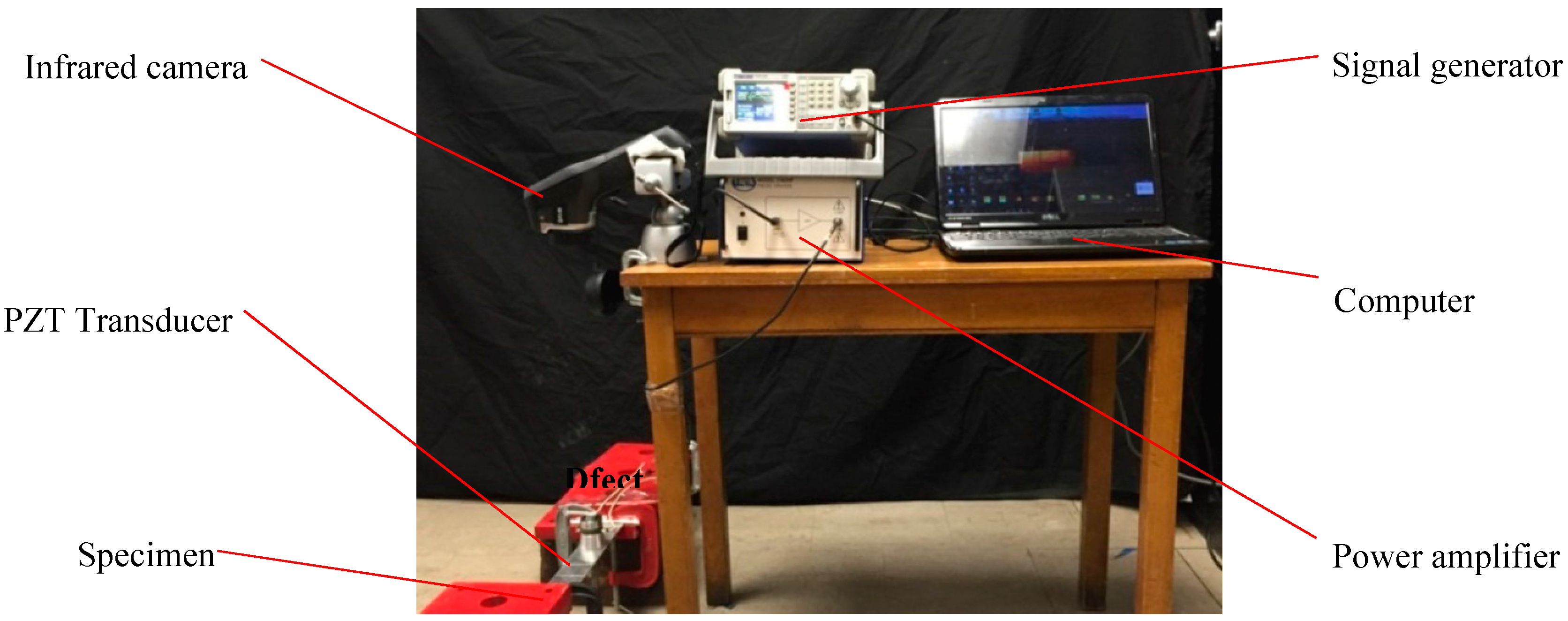
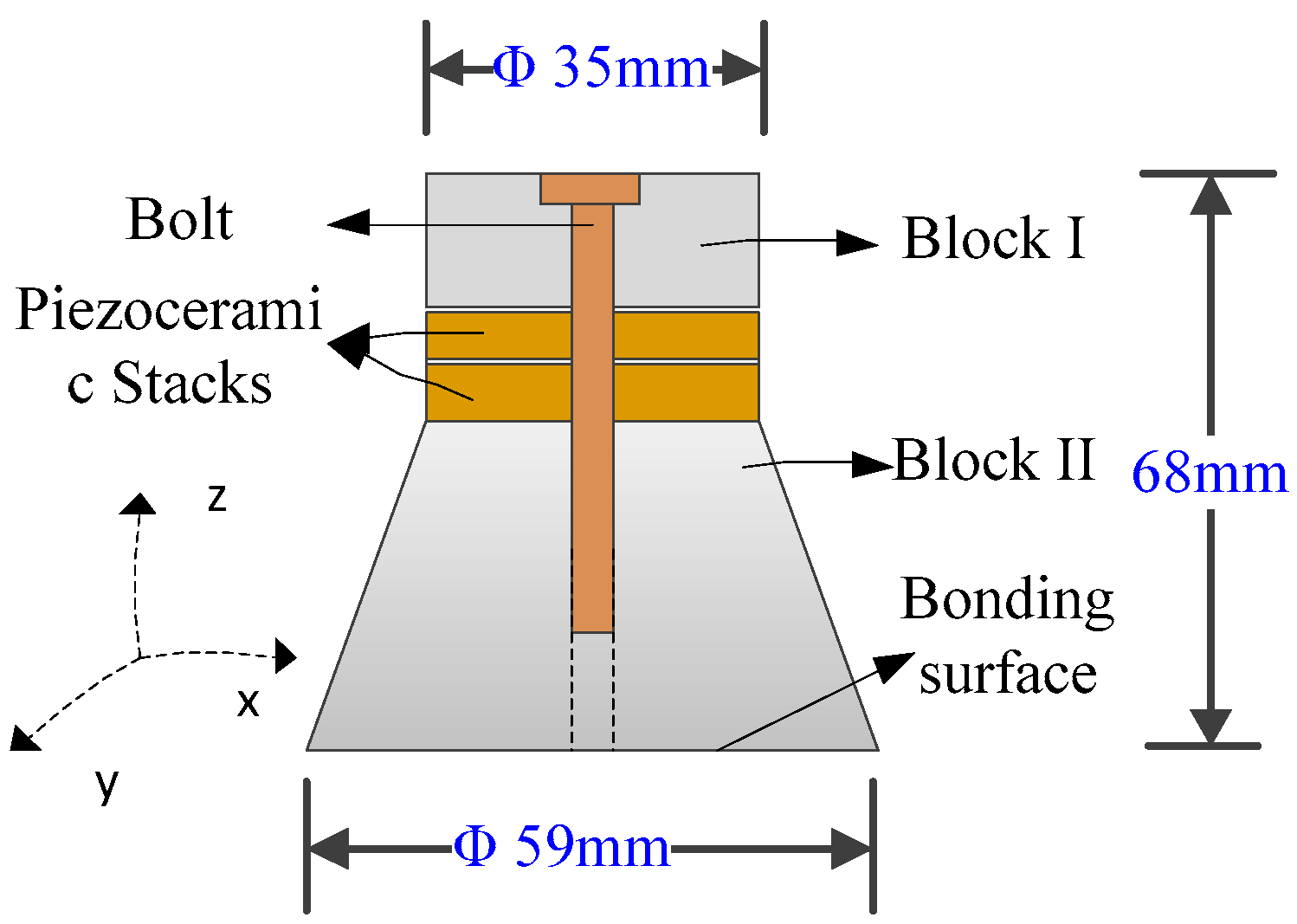
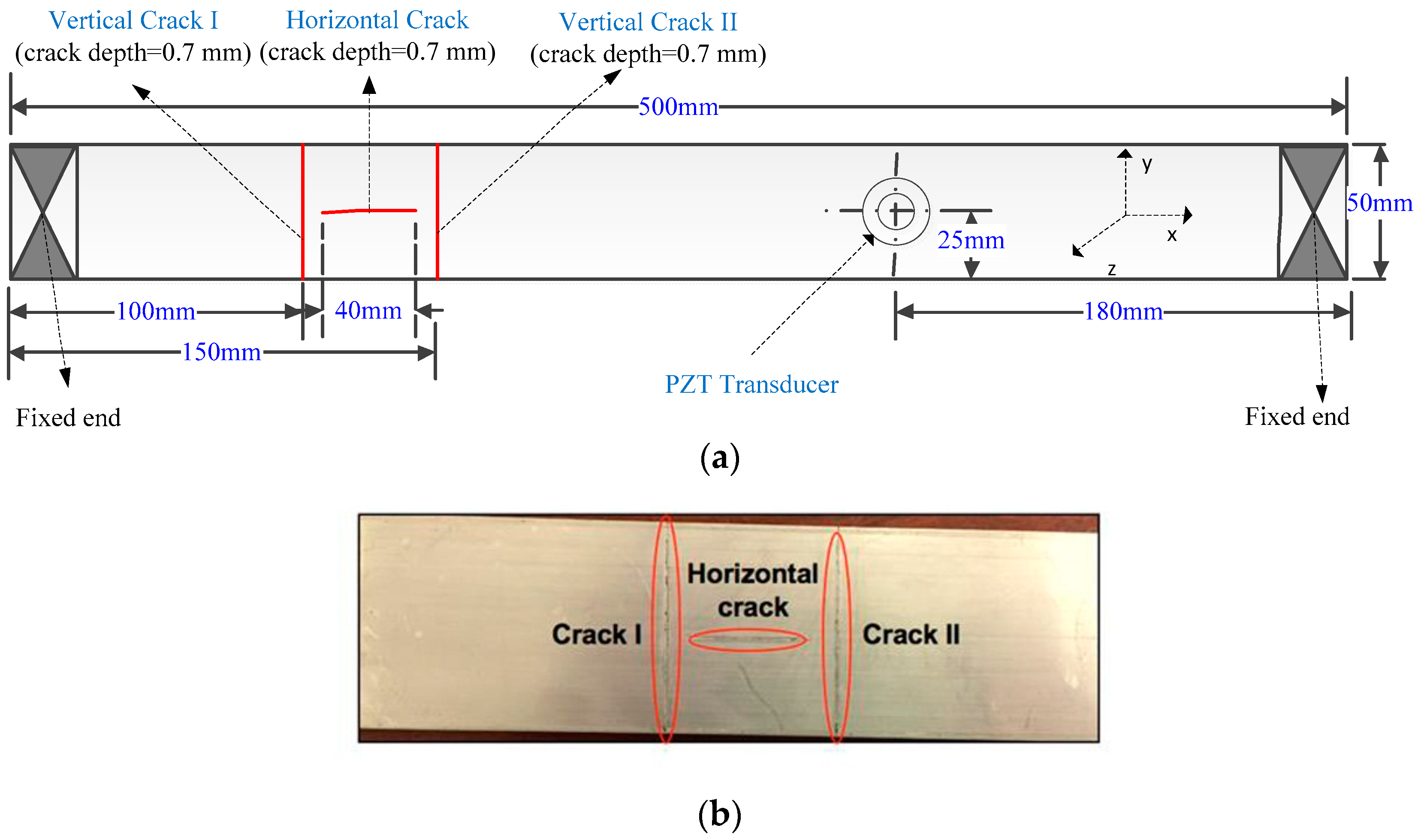
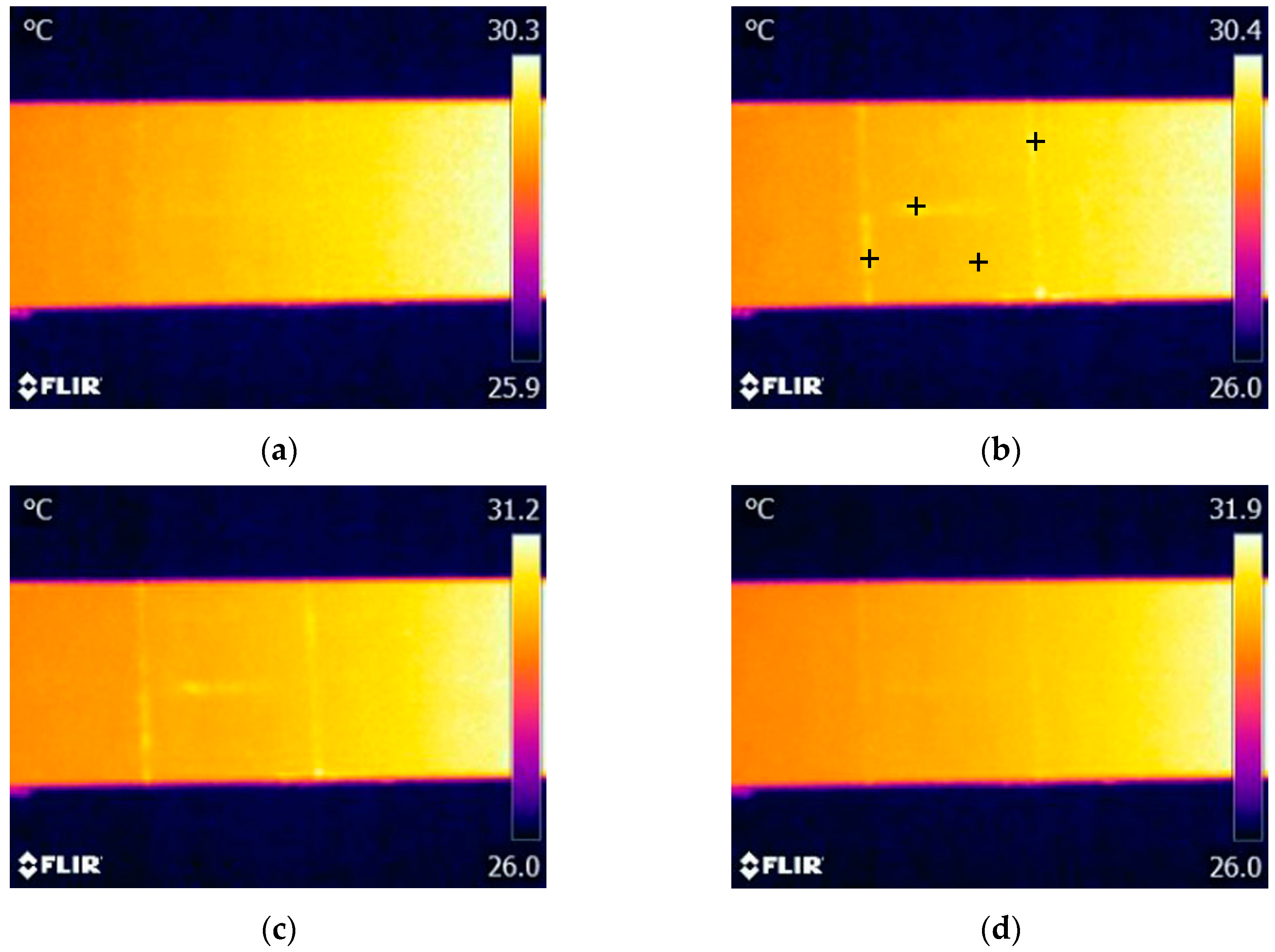

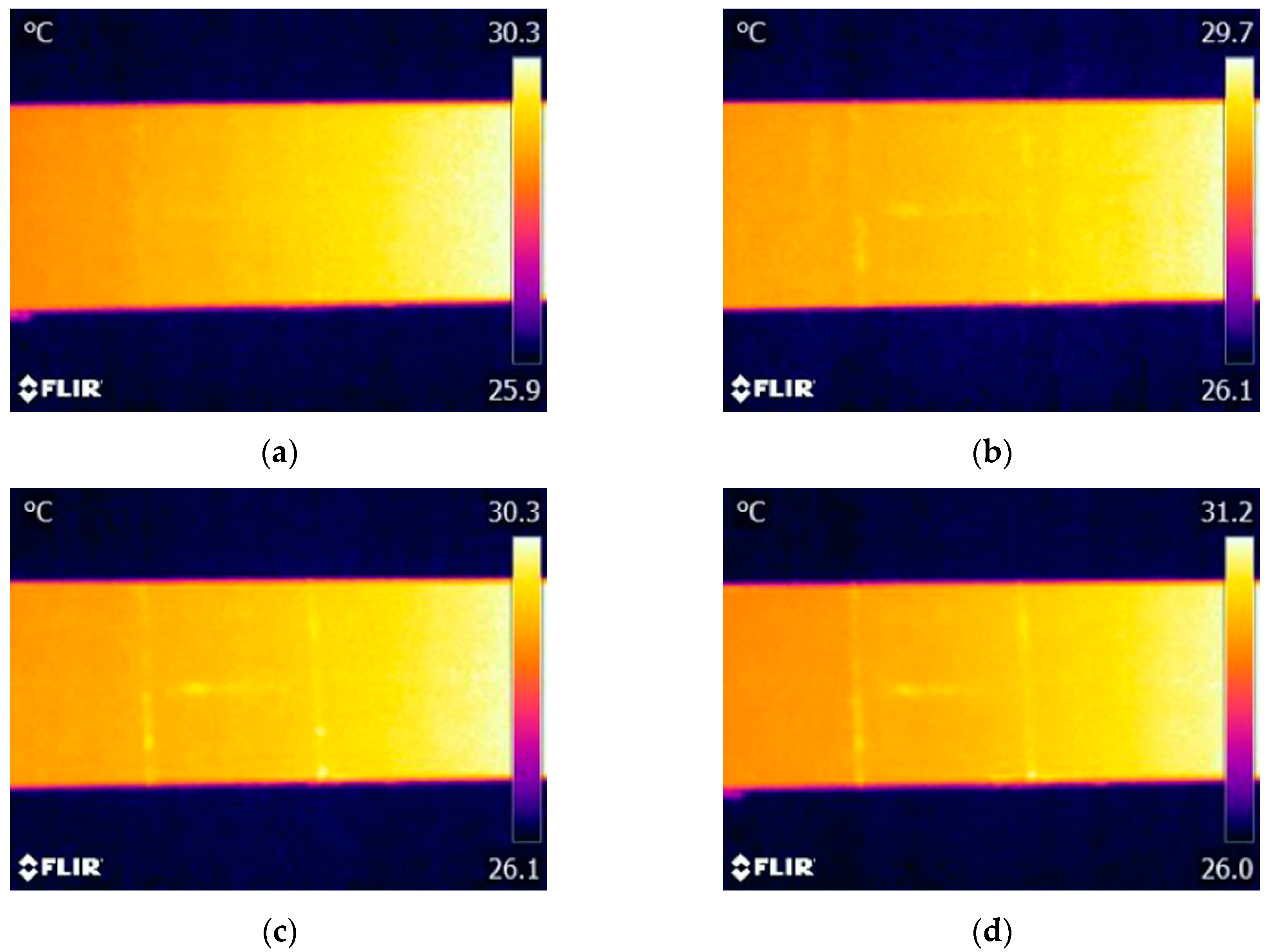


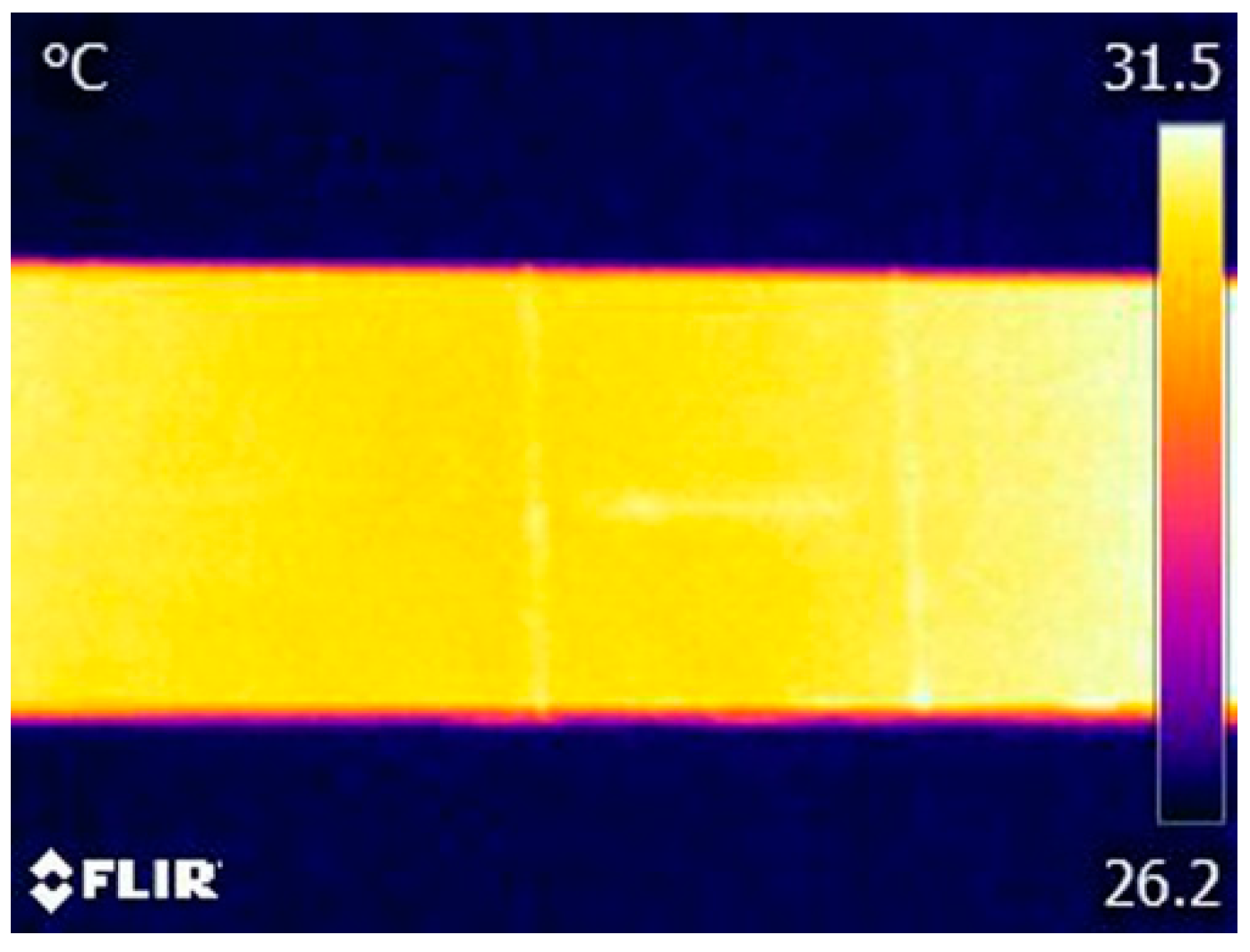
| Crack | Cracks I | Cracks II | Horizontal Crack | ||||||
|---|---|---|---|---|---|---|---|---|---|
| Voltage (V) | 80 | 120 | 150 | 80 | 120 | 150 | 80 | 120 | 150 |
| Temperature Difference (°C) | 0.3 | 0.4 | 0.7 | 0.2 | 0.4 | 0.5 | 0.4 | 0.5 | 0.6 |
© 2017 by the authors. Licensee MDPI, Basel, Switzerland. This article is an open access article distributed under the terms and conditions of the Creative Commons Attribution (CC BY) license (http://creativecommons.org/licenses/by/4.0/).
Share and Cite
Xu, C.; Xie, J.; Zhang, W.; Kong, Q.; Chen, G.; Song, G. Experimental Investigation on the Detection of Multiple Surface Cracks Using Vibrothermography with a Low-Power Piezoceramic Actuator. Sensors 2017, 17, 2705. https://doi.org/10.3390/s17122705
Xu C, Xie J, Zhang W, Kong Q, Chen G, Song G. Experimental Investigation on the Detection of Multiple Surface Cracks Using Vibrothermography with a Low-Power Piezoceramic Actuator. Sensors. 2017; 17(12):2705. https://doi.org/10.3390/s17122705
Chicago/Turabian StyleXu, Changhang, Jing Xie, Wuyang Zhang, Qingzhao Kong, Guoming Chen, and Gangbing Song. 2017. "Experimental Investigation on the Detection of Multiple Surface Cracks Using Vibrothermography with a Low-Power Piezoceramic Actuator" Sensors 17, no. 12: 2705. https://doi.org/10.3390/s17122705






